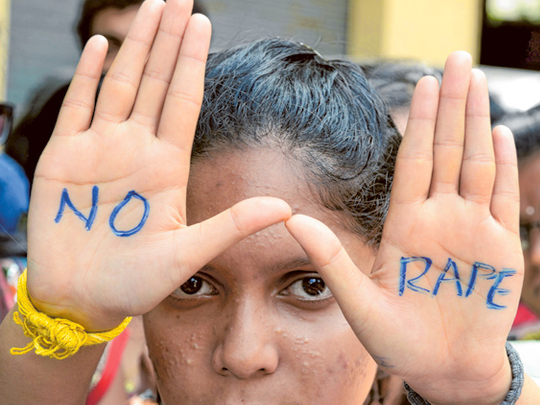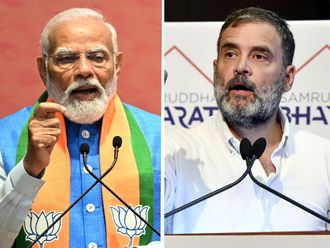
Dubai: It was 1990. A Bollywood movie featuring one of the hottest pairs of the time had just hit the screens. In those pre-internet, pre-YouTube, pre-Torrent days (sounds almost pre-historic), the only place where I could catch the film was at the neighbourhood theatre, paying a premium for a ‘rear stall’ seat.
Keeping the usual song-and-dance routine aside, what struck me as rather unusual was the male lead’s ‘attempted rape’ on the heroine – just a fake attempt to psyche her up for having earlier played a prank on him, falsely accusing him of raping her.
It was supposedly all in good humour, no offence meant.
Two-and-a-half decades later, another Bollywood star, while describing his back-breaking training schedule for a fight sequence for another Bollywood blockbuster, said, as part of an off-the-cuff banter, that trying to get under the skin of his on-screen character was the closest he could get to being raped.
Again, all in good humour, no offence meant.
- Brinda Karat | Communist Party of India-Marxist leader and Vice-President, All India Democratic Women’s Association
These forms of sacrilegious and cavalier allusions to an unpardonable, corrosive social crime take their place alongside a host of other socio-cultural attitudes to rape that include not-so-surreptitious party jokes, primetime television soap opera storylines, and the ubiquitous neta’s (political leader) sermons to women on the dress code to avoid ‘inviting’ rape.
But the counter-narrative to the apathy to rape has also been gathering force: the water cannons employed to disperse the angry mobs protesting Nirbhaya’s brutal assault on the streets of Delhi in 2012 awoke India with a force never seen before while the current worldwide clarion call of #MeToo has anchored the focus on this heinous crime with long-term soul-searching as a first response.
The more aware and conscious contemporary Indian society becomes of this bestial act, the more difficult it becomes to ignore the horrifying statistics that stare at us. According to National Crime Records Bureau, between 1971 and 2012, there was a 10-fold increase in the number of reported rape cases in India.
From roughly 2,500 such cases that were registered in 1971 to 25,000 in 2012, rape in the Indian context has long ceased to belong merely to the realm of medico-legal transgression and has come to acquire a far more invasive social characteristic that is as disturbing as the aggressive metastasising of a malignant cell. Delhi alone has seen a 277 per cent rise in rape cases from 2011-2016. And only 10 per cent of the cases get reported.
From the centuries-old Indian socio-cultural obsession with male progeny to a no-holds-barred commodification of the female form through misplaced representations in the entertainment culture, the sanction of male aggression over a woman’s physical, psychological and intellectual space has been easily granted.
What has perhaps compounded the crisis is the growing sense of affluence and a culture of mindless consumerism that a post-liberalisation India has ushered in.
True, there can be nothing wrong about being aspirational in life, but India’s struggle with the socio-economic disparities within its 1.25 billion-strong population are so stark that the ambitious growth agenda in terms of a robust GDP and purchasing-power-parity glib-talk are bound to get muddled somewhere down the line and that is precisely what we are seeing right now.
In a nation with 299.24 million smartphone users (in 2017) and with the largest Facebook footprint outside the United States, the scope of unchecked access to pernicious influences can be imagined.
In 2016, as Indian Railways was rolling out free WiFi at major stations across India, the area around Patna Junction recorded a sudden surge in internet traffic. A closer scrutiny revealed that ‘free-loaders’ in their hundreds were using the station’s free WiFi network to access porn sites on their smartphones.
According to data from 2012, 276 million people in India earned less than $1.25 a day and the unemployment figure peaked at 9.4 per cent of the population in 2010. Yet, a couple of 100 rupees in the pocket, a trip to the corner store and a few mouse clicks are all it takes to get online.
Has the dream of ‘Digital India’ gone awfully wrong? Could be. But it’s not just technology to blame. There is much that needs to be fixed -- with popular culture trivialising rape for decades; with hundreds of thousands of households accepting that it is a male prerogative to be fed first and accorded special privileges; with female foetuses aborted without an iota of remorse; with a ‘boys-will-be-boys’ bravado that patriarchy seems to have hard-wired into the collective male consciousness … the list is long.
But it’s not all gloom and doom.
At long last, India has started to at least talk about the elephant in the room. The last five years have seen a phenomenal rise in reporting cases of rape and molestation. And that’s a very important first step towards treating such crimes as a flawed gender issue and not merely an act of sexual gratification. This discernible change in discourse is one of the biggest takeaways for a young India.
INDIA: The reality of rape
Over 40 years
conviction rate for rapists shows steep decline
Only 1 in 4 rapists gets convicted
18-25 years
age group of
over half
of rape accused
96.4%
of acused in rape cases known to the victims, according to Delhi police
Conviction rate for rape cases
44.3% in 1973
37.7% in 1983
26.6% in 2010
26.4% in 2011
27.1% in 2013
2016 rape crimes in Indian metros
New Delhi 1996
Mumbai 712
Pune 354
Jaipur 330
38,947
rape cases registed across India in 2016
34,210 in 2015
2.9%
increase in crimes against women in 2016
Source: National Crime Records Bureau and Indian media sources












